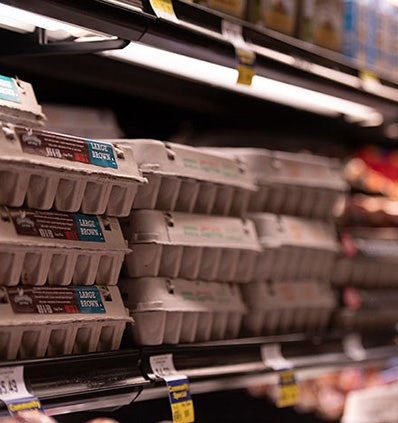
NASM's Calorie Calculator
Calorie calculator
Ever wondered how many calories you need for weight loss? Calorie calculators, like the one you'll see here, make it easy. They factor in your activity levels, overall goals, and calorie usage to help you craft a plan.
Here's the scoop on how they work:
They look at your Basal Metabolic Rate (sometimes simply called Resting Metabolic Rate), your Total Daily Energy Expenditure (TDEE), your target weight for a set date, and how you're currently splitting up carbs, fats, and proteins in your diet.
Curious about doing the math yourself? Scroll down for a step-by-step guide. And if you're really hungry for knowledge, our online nutrition courses, Weight Loss Specialization, and BMI Calculator are worth a look.
How to calculate calories
Step 1
Calculate basal metabolic rate (BMR)
Your BMR represents the number of calories your body needs to maintain its current weight without any additional activity. You can calculate it using the Mifflin-St Jeor equation:
- Men: (10 × weight in kg) + (6.25 × height in cm) - (5 × age in years) + 5
- Women: (10 × weight in kg) + (6.25 × height in cm) - (5 × age in years) - 161
Step 2
Determine total daily energy expenditure (TDEE)
Once you have your BMR, adjust it based on your activity level to get your Total Daily Energy Expenditure (TDEE):
Sedentary (little to no exercise): BMR x 1.2
- Lightly active (light exercise/sports 1-3 days/week): BMR x 1.375
- Moderately active (moderate exercise/sports 3-5 days/week): BMR x 1.55
- Very active (hard exercise/sports 6-7 days a week): BMR x 1.725
- Super active (very hard exercise & physical job or 2x training): BMR x 1.9
Your TDEE gives you the estimated number of calories you need to maintain your current weight based on your activity level.


Step 3
Set Your Goal Weight And Time Frame
If you want to lose weight, subtract 500-1000 calories from your TDEE to get a daily intake goal. For weight gain, add extra calories.
Remember, these are general guidelines. It's crucial to monitor your progress and adjust as necessary. Consulting with a nutritionist or health professional is always recommended for personalized advice.
Here’s how to estimate how long it will take to reach your goal:
Sara’s current weight is 150 lbs. She wants to lose 20 lbs.
- 150lbs - 20lbs = 130lbs.
- 20lbs loss at 2lbs/week = 10 weeks.
It will take Sara about 10 week to lose the weight.
Step 4
Break Down Macronutrient Ratios
Protein
Did you know that protein is a huge catalyst for weight loss and hunger satiation? Let's compare and contrast sedentary versus moderately active individuals and their protein requirements.
- For sedentary/lightly active individuals: 1-1.2g/kg/day
- For moderately active - extremely active: 1.4-2.2g/kg/day
How to calculate daily protein needs:
Convert body weight in pounds to kg’s (round to the nearest 10th). Multiply weight in kilograms by the range that best fits your activity levels.
Let's look at an example:
- 150lbs / 2.2 = 68.2kg
68.2kg(1g) = 68g
68.2kg(1.2) = 82g


Fat
To prevent any fatty acid deficiencies it is recommended to consume at minimum 1g/kg of fat per day. The Dietary Guidelines for Americans also recommends fat should make up 20-35% of one’s total daily calories. Using both of these references you can calculate your daily fat needs:
To calculate daily fat needs:
Convert body weight in pounds to kg's (round to the nearest 10th). Multiply weight in kilograms by 1.
Let's look at an example:
- 150lbs / 2.2 = 68.2kg
- 68g of fat needed per day
See this blog on How Much Fat Per Day for Weight Loss to learn more.
Carbohydrates
The Dietary Guidelines for Americans recommends that carbohydrates should make up 45-65% of one’s daily calories.
Calculating grams of carbohydrates. Multiply daily calorie requirements by 0.45 & 0.65 to obtain calories from carbohydrates.
a. 0.45(2000) = 900 calories
b. 0.65(2000) = 1300 calories
Divide answers in step 1 by 4 since there are 4 calories per 1 gram of carbohydrate
a. 900/4 = 225g
b. 1300/4 = 325g

Calories in common foods
Understanding the calories in everyday foods is key if you're watching your diet. Here's a quick rundown of the caloric content in some common eats, from your favorite fruits to those occasional treats.
fruits
Apple (medium): 95 calories
Banana (medium): 105 calories
Grapes (1 cup): 52 calories
Orange (medium): 62 calories
Strawberries (1 cup): 49 calories
vegetables
Broccoli (1 cup, cooked): 55 calories
Carrot (medium): 25 calories
Spinach (1 cup, cooked): 41 calories
Potato (medium, baked): 161 calories
Sweet potato (medium, baked): 112 calories
grains & cereals
White rice (1 cup, cooked): 204 calories
Brown rice (1 cup, cooked): 216 calories
Quinoa (1 cup, cooked): 222 calories
Oatmeal (1 cup, cooked): 154 calories
Whole wheat bread (1 slice): 80 calories
proteins
Chicken breast (3.5 oz, cooked): 165 calories
Salmon (3.5 oz, cooked): 206 calories
Beef steak (3.5 oz, cooked): 240-290 calories (depending on cut and preparation)
Eggs (1 large): 70 calories
Tofu (3.5 oz): 70 calories
Dairy & Alternatives
Whole milk (1 cup): 150 calories
Skim milk (1 cup): 83 calories
Cheddar cheese (1 oz): 113 calories
Greek yogurt (1 cup, plain): 130 calories
Almond milk (1 cup, unsweetened): 30-50 calories
fats & oils
Olive oil (1 tablespoon): 119 calories
Butter (1 tablespoon): 102 calories
Peanut butter (2 tablespoons): 188 calories
Almonds (1 oz, about 23 almonds): 164 calories
Avocado (half): 114 calories
sweets & snacks
Chocolate (1 oz): 140-150 calories
Ice cream (1/2 cup, vanilla): 145 calories
Potato chips (1 oz): 152 calories
Soda (12 oz can): 150 calories (approx)
Cookie (1 medium chocolate chip): 50 calories
Beverages
Coffee (8 oz, black): 2 calories
Tea (8 oz, without sugar): 2 calories
Beer (12 oz): 150 calories (can vary based on type)
Wine (5 oz): 120-130 calories
Remember, the caloric content of foods can vary based on preparation methods, portion sizes, and specific brands. Always check nutrition labels when available. If your goal is to monitor your intake closely, consider using a food diary app or a digital kitchen scale to measure portions.
Frequently Asked Questions (FAQs)
How many calories should I eat?
The number of calories you should be consuming daily depends on several factors, including:
Age: Caloric needs tend to decrease as we age.
Gender: Men generally require more calories than women because they typically have more muscle mass, which burns more calories than fat.
Activity level: A sedentary person requires fewer calories than someone who is highly active.
Weight: Your current weight and whether you're trying to lose, maintain, or gain weight affects your caloric needs.
Height: Taller individuals generally require more calories.
Metabolism: Some people naturally burn calories faster or slower than others.
Overall Health: Certain medical conditions or medications can affect your metabolism and, subsequently, your caloric needs.
To get a general estimate:
Sedentary (little to no exercise) Women: 1,800 to 2,400 calories Men: 2,200 to 3,000 calories
Moderately active (engages in moderate exercise/physical activity like walking or light yard work:
Women: 2,000 to 2,600 calories
Men: 2,400 to 2,800 calories
Very active (engages in hard exercise/physical activity, or has a physically demanding job):
Women: 2,200 to 2,800 calories
Men: 2,800 to 3,200 calories
These are just general guidelines. It's essential to consult with a nutritionist or a doctor who can give personalized advice based on your specific situation. Remember, it's not just the quantity but also the quality of calories that matters for overall health.
How many calories should I eat to lose weight?
For a healthy and sustainable weight loss journey, it's typically recommended not to shed more than 2 pounds of fat weekly. This translates to a daily calorie deficit of 1,000 calories. It's essential to note that when weight loss surpasses 2lbs within a week, it's often water weight being lost, not just fat.
For those leading a more sedentary lifestyle, aiming to lose 1lb per week is a good starting point. This means creating a daily calorie deficit of 500 calories.
On the other hand, those who are more active naturally have higher daily calorie needs. So, when they're trying to lose weight, they can afford to eat a bit more since their maintenance calories are already elevated.
For such individuals, aiming for a daily calorie deficit of 500-1,000 calories is realistic, potentially leading to a weight loss rate of up to 2lbs weekly.
Pro tip: Pairing regular exercise with a modest calorie deficit offers the best results. Also, consuming a protein-rich diet, especially at the higher end tailored to your activity level, can help retain muscle mass while shedding fat. Remember, it's all about balance and making choices that support your individual needs and goals.
What happens when your calories are too low?
Consuming calories below your body's needs for an extended period can lead to various physiological and psychological consequences. Here's what can happen when your caloric intake is too low:
Slower metabolism: Your body might slow down its metabolic rate as a defense mechanism to conserve energy. This can make weight loss harder over time and weight regain more likely once normal eating resumes.
Nutrient deficiencies: Low calorie intake can lead to inadequate intake of essential vitamins and minerals. Over time, this can result in conditions like anemia, osteoporosis, and impaired immune function.
Loss of muscle mass: Your body might start breaking down muscle tissue for energy, especially if protein intake is inadequate. This can further slow down metabolism and lead to weakness.
Hormonal changes: Reduced calorie intake can affect hormone levels, leading to disruptions in menstrual cycles for women, reduced bone density, and other hormonal imbalances.
Reduced energy and fatigue: You might feel constantly tired or find it difficult to concentrate.
Mood changes: Low caloric intake can influence mood. This can result in irritability, depression, or anxiety.
Impaired Immune Function: Your body might become more susceptible to infections due to a weakened immune system.
Hair and skin problems: You might experience hair loss, dry skin, or brittle nails due to inadequate nutrient intake.
Digestive problems: Constipation or other digestive issues can occur as a result of reduced fiber and fluid intake.
Fertility issues: Low calorie and nutrient intake can lead to fertility problems in both men and women.
Cardiovascular problems: Chronic low calorie intake can affect heart health, leading to low blood pressure, irregular heart rhythms, or other cardiovascular issues.
Increased risk of gallstones: Rapid weight loss from very low-calorie diets can lead to the development of gallstones.
In extreme cases, consistent severe calorie restriction can result in
